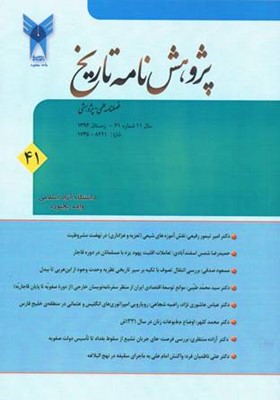-
-
List of Articles
-
Open Access Article
1 - The role of Shiite teachings (Taziyeh and mourning) in the Constitutional Movement
amirtimoor rafiei mohsen agahasani -
Open Access Article
2 - Interactions of JewishMinorityofYazdwithMuslimsintheQajar Period
hamidreza shams esfandiari naser jadidi fezzolahi boshasbgoshe -
Open Access Article
3 - A Survey of the Spread of Sufism in India with an Emphasis on the Historical Development of Pantheism from IbnArabi to Bidel
Masood sedghi Abolfazl Mahmoodi -
Open Access Article
4 - Barriers to Economical Development of Iran from the Point of View of Foreigner Logbook Writers (fromSafavids to Qajar)
seyed mohamad tayebi seyed shams najmi -
Open Access Article
5 - British and Ottoman encounter in Persian Gulf
Abbas Ashurinejad Ashurinejad Raziyeh Shojaie -
Open Access Article
6 - The Situation of Women Journals in 1331
Mohamad Kalhor Maryam Haji Bagher Najar -
Open Access Article
7 - Investigation of Shi'ism current opportunities from the fall of Baghdad To the establishment of the Safavid dynasty
Azadeh Montazeri -
Open Access Article
8 - The Reaction Of Imam Ali to the Saqifa Accident in the Nahj al-Balagha
Ali Nazemianfard
-
The rights to this website are owned by the Raimag Press Management System.
Copyright © 2021-2025







